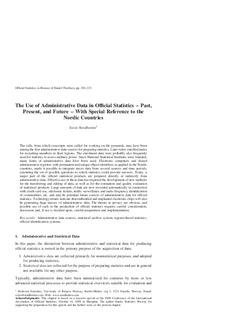| dc.contributor.author | Nordbotten, Svein | |
| dc.date.accessioned | 2010-11-24T19:24:23Z | |
| dc.date.available | 2010-11-24T19:24:23Z | |
| dc.date.issued | 2010 | |
| dc.identifier.citation | Nordbotten, S. (2010). The use of administrative data in official statistics - past, present and future : with special reference to the Nordic countries. In: Michael Carlson, Hans Nyquist, Mattias Villani (red.), Official statistics : methodology and applications in honour of Daniel Thorburn, pp. 205-223, Stockholm | en_US |
| dc.identifier.isbn | 978-91-633-6750-2 | |
| dc.identifier.uri | http://hdl.handle.net/11250/181409 | |
| dc.description | Published 2010 by the Department of Statistics, Stockholm University: Stockholm, Sweden (in collaboration with Statistics Sweden). Kapittelet er gjengitt med tillatelse fra Stockholm Universitet, Statistiska institutionen. | en_US |
| dc.description.abstract | The rolls, from which conscripts were called for working on the pyramids, may have been
among the first administrative data sources for preparing statistics. Later rulers enrolled males
for recruiting members to their legions. The enrolment data were probably also frequently
used for statistics to assess military power. Since National Statistical Institutes were founded,
many kinds of administrative data have been used. Electronic computers and shared
administrative registers with permanent and unique object identifiers as applied in the Nordic
countries, made it possible to integrate micro data from several sources and time periods,
extending the set of possible questions to which statistics could provide answers. Today, a
major part of the official statistical products are prepared directly or indirectly from
administrative data. Effective use of these data has required the development of new methods
for the transferring and editing of data, as well as for the estimation and quality evaluation
of statistical products. Large amounts of data are now recorded automatically in connection
with credit card use, electronic tickets, traffic surveillance and radio frequency identification
of commodities, etc. and may be potential future sources of administrative data for official
statistics. Technology trends indicate that embedded and implanted electronic chips will also
be generating huge masses of administrative data. The threats to privacy are obvious, and
possible use of such in the production of official statistics requires careful consideration,
discussion and, if use is decided upon, careful preparation and implementation. | en_US |
| dc.language.iso | eng | en_US |
| dc.publisher | Department of Statistics, Stockholm University | en_US |
| dc.subject | Svein Nordbotten | en_US |
| dc.subject | Statistical archive system | en_US |
| dc.subject | Register-based statistics | en_US |
| dc.subject | Official identification systems | en_US |
| dc.subject | Administrative registre | en_US |
| dc.title | The use of administrative data in official statistics - past, present and future : with special reference to the Nordic countries | en_US |
| dc.type | Chapter | en_US |
| dc.subject.nsi | VDP::Mathematics and natural science: 400::Mathematics: 410::Statistics: 412 | en_US |
| dc.source.pagenumber | 205-223 | en_US |
